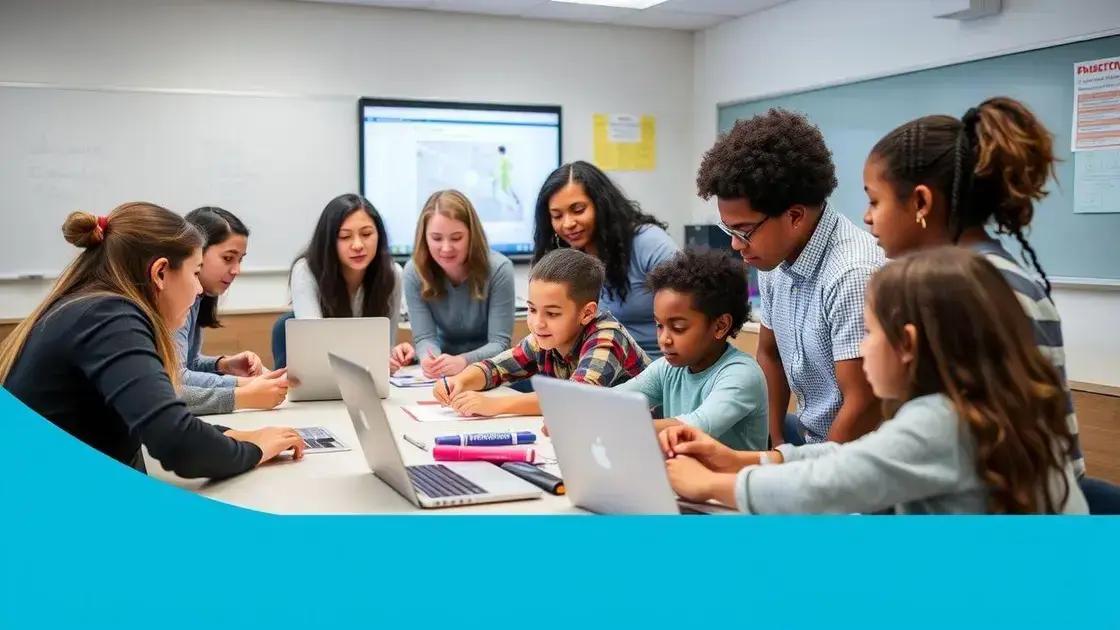Digital literacy programs: empowering communities for success

Anúncios
Digital literacy programs teach essential technology skills, empower individuals across various demographics, and enhance community connectivity, leading to increased employability and personal growth.
Digital literacy programs are vital in our increasingly digital world, enabling individuals to navigate technology confidently. Have you considered how these programs can transform lives and create opportunities? Let’s dive deeper into the subject.
Anúncios
Understanding digital literacy tools
Understanding digital literacy tools is essential as we navigate our technology-driven world. These tools can enhance our daily lives and empower individuals to succeed. Knowing what tools are available is the first step toward developing strong digital skills.
Types of Digital Literacy Tools
There are several types of tools that can aid in building digital literacy. Here are some common examples:
Anúncios
- Online Learning Platforms: Websites like Coursera and Khan Academy provide access to countless courses.
- Digital Collaboration Tools: Tools such as Google Workspace and Microsoft Teams allow users to work together in real-time.
- Content Creation Software: Programs like Canva and Adobe Spark assist with creating engaging content.
- Communication Apps: Platforms like Zoom and Slack are crucial for remote communication.
With the right digital literacy tools, individuals can improve their skills and increase their confidence. Each tool serves a different purpose, catering to various needs and learning styles.
Recognizing the Importance
Being competent with these tools opens doors to numerous opportunities. For example, knowing how to use online learning platforms can expand educational horizons. Meanwhile, familiarity with collaboration tools can enhance workplace productivity.
Moreover, as technology evolves, new tools continually emerge. Keeping updated with these changes is part of becoming digitally literate. Engaging with community tech classes or group sessions can provide hands-on experience with the latest tools.
As you explore digital literacy tools, remember that practice is key. The more you interact with different platforms, the more comfortable you will become. It’s about developing a mindset that embraces learning and adaptation in a digital world.
Benefits of digital literacy programs
Understanding the benefits of digital literacy programs is crucial in today’s technology-oriented society. These programs not only teach essential skills but also foster confidence and adaptability among participants.
Enhancing Employment Opportunities
One of the primary advantages of digital literacy programs is increased access to job opportunities. Many employers look for candidates who are digitally savvy. Having strong digital skills can make a resume stand out.
- Improved understanding of technology.
- Ability to use digital tools for job applications.
- Access to online job boards and career resources.
Moreover, as industries evolve, so do the skills needed to succeed. Participants learn to navigate various platforms and tools that increase their employability.
Building Confidence
Digital literacy programs also help participants build confidence in their abilities. This is especially important for individuals who may feel intimidated by technology. Through hands-on practice, they learn to explore and utilize tools effectively.
Feeling competent with technology can reduce anxiety in many situations, such as applying for jobs online or collaborating with others remotely. Engaging in these programs allows individuals to take control of their digital skills.
Additionally, becoming part of a learning community can boost motivation. Participants support each other through challenges, creating positive networks that extend beyond the classroom.
The benefits of digital literacy programs extend into personal life as well. With strong digital skills, individuals can manage their finances online, connect with family through social media, and access vital information quickly.
As technology continually changes, the importance of being digitally literate becomes more paramount. Embracing the learning process allows individuals to adapt to shifting environments and thrive in an increasingly digital world.
How to create effective digital literacy programs

Creating effective digital literacy programs requires careful planning and understanding of the community’s needs. By tailoring the program to specific demographics, you can ensure greater participation and engagement.
Assessing the Needs
The first step is to assess the needs of your target audience. Conduct surveys or focus groups to gather information on their current skills and what they wish to learn. Understanding these factors will inform the program’s content and structure.
- Identify skill gaps in the community.
- Determine technology access among participants.
- Gather feedback on preferred learning methods.
Once you have assessed the needs, you can develop a curriculum that addresses these areas. The curriculum should be flexible enough to adapt to different learning paces.
Incorporating Hands-On Learning
Hands-on learning is crucial for effective digital literacy programs. Participants should have ample opportunities to practice what they learn. This can include group projects, individual assignments, and real-world applications of digital tools.
Utilizing experienced instructors who can guide participants through practical exercises is also important. Instructors can encourage questions and provide tips that enhance understanding.
Encouraging peer-to-peer learning can also boost confidence. When participants work together, they can share insights, troubleshoot issues, and celebrate successes as a group.
As participants gain skills, it’s essential to recognize their progress. Providing certificates or badges upon completion can motivate individuals and give them a sense of achievement. This acknowledgment can boost their confidence and encourage further learning.
Finally, continually evaluating and updating the program based on feedback is key. Stay informed about new technologies and trends to ensure that the program remains relevant and effective.
Challenges in implementing digital literacy initiatives
Implementing digital literacy initiatives can come with various challenges that need to be addressed for success. Understanding these obstacles is essential for developing effective programs.
Lack of Access to Technology
One of the main challenges is the lack of access to technology for some individuals. Not everyone has reliable internet or devices needed for participation. This gap can make it hard for certain groups to engage fully.
- Rural areas may have limited internet connectivity.
- Low-income households may not own computers or tablets.
- Many people lack knowledge about available resources.
To overcome these barriers, initiatives can provide resources like loaner devices or partner with local libraries to offer free internet access.
Resistance to Change
Another challenge is resistance to change. Some individuals may feel overwhelmed or intimidated by new technology. This fear can lead to hesitation in participating in digital literacy initiatives.
To address this, it’s important to create a welcoming environment. Implementing gradual learning steps can help participants build confidence. Offering support from instructors and peers can also ease fears associated with technology.
Creating success stories within the community can motivate others to join. When individuals see their neighbors thriving, they may feel encouraged to engage as well.
Insufficient Training and Resources
Additionally, many programs suffer from insufficient training and resources. If instructors are not well-prepared or lack knowledge of the tools, participants will not receive effective guidance. Programs need to prioritize instructor training and provide proper materials to support their teaching.
Creating comprehensive training sessions can ensure instructors feel confident in their abilities. Partnering with experienced organizations may also provide valuable resources for educators.
Implementing digital literacy initiatives may have challenges, but recognizing these issues allows for better planning and resource allocation. By actively working to overcome obstacles, these programs can thrive, benefiting communities and individuals alike.
Success stories of impactful digital literacy programs
Success stories from impactful digital literacy programs illustrate how these initiatives can transform lives. These examples demonstrate the positive effects of teaching digital skills in various communities.
Community-Based Programs
In many areas, community centers have implemented digital literacy programs that focus on local needs. For example, a community center in a low-income neighborhood provided classes tailored to seniors. Participants learned how to use smartphones and access the internet safely.
- Seniors gained confidence navigating technology.
- Many discovered online resources for health and wellness.
- Anecdotes of connecting with family through video calls flourished.
This program not only equipped seniors with essential skills but also fostered social connections, reducing feelings of isolation.
School Initiatives
Another success story comes from a school district that introduced a digital literacy curriculum for all grades. Teachers integrated technology into everyday lessons, allowing students to develop essential skills early on.
Students learned to research online, create presentations, and collaborate through digital platforms. By the end of the program, many students reported feeling more prepared for future education and the workforce.
As a result, several students even went on to lead workshops for their peers, showcasing their newfound skills. This peer-led approach encouraged a culture of learning and support.
In addition, parents noticed a difference in their children’s confidence with technology, leading to increased support for the program.
Workforce Training Programs
Many workforce training programs have successfully integrated digital literacy, helping job seekers improve their overall employability. A notable example involved a partnership between a local organization and businesses in the area.
The program provided participants with training on resume writing, job searching online, and using communication tools effectively. Participants who completed the program had a higher rate of job placement within six months.
Success stories within these initiatives often include personal accounts of individuals who found work after learning digital skills. Many of these individuals express gratitude for the opportunities they never thought possible.
These stories highlight the lasting impact of digital literacy programs, emphasizing how access to technology and training can change lives positively. By sharing these successes, we can inspire further investment in similar initiatives.
FAQ – Frequently Asked Questions about Digital Literacy Programs
What are digital literacy programs?
Digital literacy programs teach individuals essential skills to navigate technology and the internet effectively.
Who can benefit from digital literacy programs?
Anyone can benefit, including students, seniors, job seekers, and anyone wanting to improve their digital skills.
How do these programs impact communities?
They empower individuals, bridge technology gaps, and foster collaboration, leading to stronger community connections.
What are some examples of successful digital literacy initiatives?
Successful initiatives include community workshops for seniors, school curriculums, and workforce training programs that have helped many find jobs.






